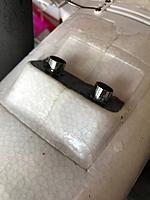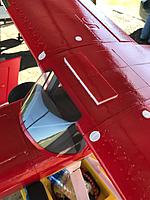Archive for April, 2018
-
 Views: 81
Views: 81
Chrome antenna tube is notched with a Dremmel then turned by hand to make the holes -
 Views: 75
Views: 75
Two 1 inch sections are GGlued in. A black Sharpie is used over the white foam. -
 Views: 85
Views: 85
ISDT battery capacity meter and alarm on dashboard with balance tap routed forward. -
 Views: 74
Views: 74
The Thrust 3200 3S 40 C was tight before but with aft battery floor removed it fits on an angle.. -
 Views: 83
Views: 83
Dremmel with a drill makes holes from the belly pan opening. -
 Views: 81
Views: 81
Comments (0)
Add Comment
-
 Views: 91
Views: 91
The forward piece that is lifted out from the fuse. The spar tube forward edge is the aft cut line. -
 Views: 85
Views: 85
Two box cutters are used to pry the foam block free. -
 Views: 81
Views: 81
The forward foam block removed. -
 Views: 76
Views: 76
The aft and center foam pieces are removed. The spar tube has been scraped and cleaned of foam and adhesive. Note the clear plastic skylight and the screw used to secure the aft skylight. -
 Views: 100
Views: 100
Here the spar tube is being removed. -
 Views: 96
Views: 96
View of the skylight
-
 Views: 78
Views: 78
Foam on aft end positions pack for forward CG. -
 Views: 73
Views: 73
Pack is inserted on top of battery strap. Here the strap is visible and available for making a back up loop that does not have to be tight. Use this “loose loop” if you worry about the door falling away from the fuselage during negative G forces.
-
 Views: 72
Views: 72
Stock elevator servo with H bends at ends. The U bend replaces a clevis for fine adjustment. -
 Views: 90
Views: 90
The new EMax servo is mounted forward of the rudder servo where the fuse is hollow. A new elevator horn is bolted in place. Drill out the horn and arm so the 2-56 rod and Dubro clevis pin are the same diameter. I measured a .072 inch O.D. wire drill. -
 Views: 106
Views: 106
Joiner gets cut so left and right elevators can operate individually.











